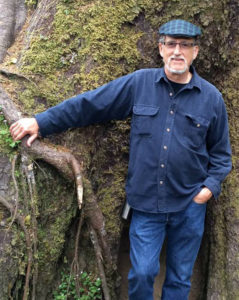August 4, 2018
by John Creger
 When I met Riane Eisler at a conference in 2000 and began reading her books, I was ten years into my career as a high school English teacher. My own high school education had been dissatisfying and disheartening for me, its emphasis on competing for spots in Ivy League colleges precluding the more personal kind of learning I hungered for. So, intuitively, I had made my own classroom a place for my sophomores to solidify their academic development with self-discovery, and formed myself into what I would now describe as a partnership teacher.
When I met Riane Eisler at a conference in 2000 and began reading her books, I was ten years into my career as a high school English teacher. My own high school education had been dissatisfying and disheartening for me, its emphasis on competing for spots in Ivy League colleges precluding the more personal kind of learning I hungered for. So, intuitively, I had made my own classroom a place for my sophomores to solidify their academic development with self-discovery, and formed myself into what I would now describe as a partnership teacher.
I design our classroom and courses to guide my students not only to gain academic skills, but to unfold themselves with help from what I call the personal leg of curriculum, according to their age-group developmental capacities. The growing knowledge they gain of themselves and their classmates from the personal leg enriches their academic growth and helps them understand how they fit in the world. Though this kind of ?two-legged? approach actually better equips students to successfully carve our their careers in college and beyond than the overly competitive norm in education, it remains ?non-traditional.? One of my students acknowledged this in his course evaluation: ?I must say that this year is the first time ever, in any of my classes, that I have?been introduced to personal discovery in relation to learning.? While it was intuition that first prompted me to carve out my approach to teaching, Riane?s insightful friendship and the power of her ideas have guided me to understand on a deeper and more conscious evolutionary level what I am trying to accomplish as a teacher, and how I can do it better.
Riane has influenced one of my earliest efforts, the Personal Creed Project, which has borne fruit beyond my classroom. In 17 weekly reflections, my students identify and explore in writing the major forces and people that have shaped their lives so far, distilling this list into their three to five most significant influences. They then reflect on what specific values each of their ?short list? influences has taught them. Finally, each student stands before the class and shares four project findings: a) their most significant influences, b) the values they have discerned from these influences–their ?creed values?– c) the qualities they wish to develop to help them live by their creed values over the next five to ten years, and d) the difference they wish to make in others? lives. Students in schools and colleges around the country where their teachers are adapting the project experience Personal Creed presentations as transformative rites of passage.
The power of Riane Eisler’s ideas have guided me to understand on a deeper and more conscious evolutionary level what I am trying to accomplish as a teacher, and how I can do it better.

Several years ago, I had the privilege of driving Riane to an event in San Francisco at which she was a keynote speaker and I was also presenting. Two hours of traffic gave us a long opportunity to talk, and I described the Personal Creed Project to her. She listened with enthusiasm, peppering me with questions. Basking in her interest, flattered at this attention from someone I admired, I was taken aback with a somewhat sharpened tone in her next question: ?This is all terrific, John. But your project includes nothing about gender roles!? With Riane?s help and feedback, I added a reflection on gender to the project. This was a few years before the shift to the more fluid notions of gender many students embrace today, and the topic of gender roles felt a little stiff the first year or two. Now, however, students seem to take naturally to reflecting on this aspect of their identities as it pertains to what they value. Riane?s input helped me keep the project current and relevant.
But it is Riane?s thinking on partnership values?caring in particular?that is having the greatest impact on my students? learning in recent years. Inspired by her recent work applying caring to the field of economics, I have worked with my colleagues to develop a single over-arching question to guide the courses we teach sophomores across the curriculum at our school.
Our Sophomore Core Question has become: ?How can a sophomore help build a caring world??
In my own courses, each quarter develops a different aspect of this yearlong question.
First quarter begins the year with: ?How can a sophomore make deeper connections with self, others, and world?? This is the driving question of our World Wisdom Project.
Second quarter: ?Why do human beings so often choose violence over caring?? Here we explore the Holocaust and racism in America.
Third quarter: ?How can the struggles and contributions of women guide us in building a caring world?? For this study we read Khaled Hosseini?s A Thousand Splendid Suns, Jane Eyre, and students? choices from a selection of contemporary novels and nonfiction.
Fourth quarter: ?How can knowing what we value help us build wisely toward a caring world?? Here, students are themselves experiencing the transformational Personal Creed presentations as we study Les Miserables or Zora Neale Hurston?s Their Eyes Were Watching God.
Focusing us on the umbrella question about building a caring world, our explorations of these four questions power our learning through the year. Our multifaceted, yearlong pursuit of caring?arguably the core partnership value?enriches my students? lives and learning, and helps them engage in thinking they need to play active, effective roles as global citizens.
For example, this spring Alicia introduced her third quarter essay on ‘Women and the Partnership Future’:
Throughout history, government systems have continuously changed and developed to be in harmony with society. However, as these established methodologies worked towards improvement, one issue remains unresolved and constant: the male dominance notion. Defined by Riane Eisler, author of?The Chalice and The Blade,?the dominator model is a world that suppresses the talent and intellect of women, so men can prevail and control. Yet, an alternative to this cruel and unjust paradigm is the partnership model ? a society in which men and women are interconnected and submission is not equated with gender. In the stories?A Thousand Splendid Suns?by Khaled Hosseini,?Jane Eyre?by Charlotte Bronte, and?Les Miserables?by Victor Hugo, the main female protagonists exhibit qualities that challenge the dominator model while reforming society to partnership values.
Alicia concludes her essay:
In their battles against their personal dominators, Mariam, Jane, and Fantine all harness their unique qualities to achieve their goal: gender equality. By working towards this common goal, these women are laying the groundwork for a much more advanced world. If the world was to be deprived of female potential, the progress towards betterment will be hampered, therefore creating a devastating impact on society. This fight is not just a female one, but a human one. In order to reach a society where a partnership is the key ideal, all of us must fight to break down these rigid gender roles that society has implemented on itself.
Student presentation in John Creger’s class from the?Global Citizen Project.?The project demonstrates partnership values in its collaboration among cross-ethnic teammates coming together to research and propose solutions for a global problem, in this case police brutality again African-Americans.
?If I could describe my experience in the CPS Young Leaders Program with just one word, I?d say it has been life-changing.? ?Anjali Devakumar,? American High School, Fremont, California
As I launch my seminar series for educators, my mission is to share with as many teachers as possible what I?m learning about how to make a partnership approach to education alive and real in students? lives. I invite colleagues to learn more at www.personalcreed.com and share their work in conversation on our blog.
What are we educators doing and learning in the emerging field of partnership education?
John Creger is a certified Partnership leader and regularly shares Center for Partnership Studies’ programs with his students. Visit John’s website, The Personal Creed Project, to learn more about partnership-based curriculum, student projects, and John’s professional development seminars “Thriving at the Core“. Contact John at?jcreger@jps.net.






Greetings! I?m especially pleased to see this student presentation video here, one of the more inspired I?ve recorded in the classroom. This team was from my least ?academic? class last year. Nonetheless, at points through the year each member of this team produced at least one top essay. To have them all working together on this team, and on this topic, was pretty special.
One compelling point about this video is the partnership values these kids demonstrate in their presentation. Though not as smooth and professional as kids in an honors class would be, this diverse team shows a cohesive collaboration in their presentation. They show a commitment to the common good. And they show a clear willingness to stand up for the rights of one another’s cultures.
What partnership elements of the course and my teaching would you guess set them up to create this presentation?